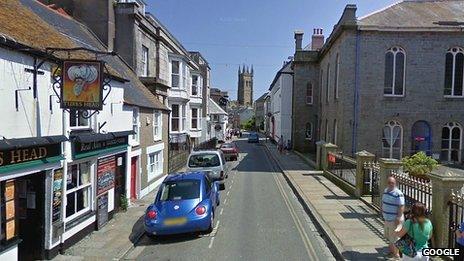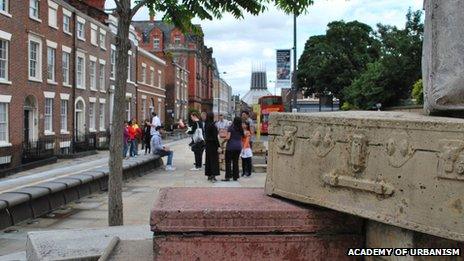London, Liverpool and Penzance on road to recognition
- Published
A trio of streets in England have been shortlisted for a national award aimed at recognising the best examples of urban places in Europe.
Last year, Lincoln's Steep Hill was chosen for the top spot, external by the Academy of Urbanism.
This year, streets in Liverpool, London and Penzance are all contenders for the Great Street Award, which is one of five categories in the Urbanism Awards 2013.
The academy uses the awards to learn from and promote best practice in planning and urbanism - but what makes a street a success?
Chapel Street, Penzance

Chapel Street links the town centre to the harbour
For David Gray, Chapel Street's popularity is down to a range of factors, not least its location in Cornwall.
"Image benefits us," he said. "Cornwall is a well-known holiday destination so people search the internet before they come to visit the area. It creates tremendous publicity for us."
As well as being based in a holiday resort, the road itself connects two tourist destinations.
He said: "It's the main street from the centre of town to the harbour so we get a lot of passing traffic."
Mr Gray, who runs craft shop Iriss with his partner, said the street was popular with locals and tourists because of its mix of quirky shops and traditional family-run businesses.
"It's a tourist spot so we get summer trade as well as good winter trade from locals," he said.
"There's a brilliant butchers opposite our shop where people queue outside, there's a bargain store, some lovely pubs, gift shops and art galleries so there's a very wide mixture which is part of what keeps trade healthy."
Exhibition Road, London

Exhibition Road is now a "shared-space"
Even if you have not heard of Exhibition Road you will have heard of some of the famous cultural and scientific institutions that line the street - the Victoria and Albert Museum, the Royal Albert Hall, Imperial College London and the Royal College of Music to name a few.
The road is named after the Great Exhibition of 1851, which established Britain as a major player in manufacturing - when the exhibition closed a number of scientific and cultural institutions were established to continue a legacy of innovation in the capital.
Paul Cutts, chief executive of the Exhibition Road Cultural Group, said the street continued to be a huge draw for visitors today.
He said: "Ten years ago, stakeholders got together to see what they could do to reflect the global significance of these institutions.
"Historically people came [to the street] to go to the Science Museum or a prom at the Albert Hall - they didn't go to the street as a destination."
To make the road more user friendly a £30m redevelopment scheme was carried out to create a "shared-space" which aimed to make the road equally accessible to vehicles and pedestrians through a kerb-free single surface with no barriers.
Mr Cutts said the feel of the road had changed as a result of the project. "We've really noticed the street has come alive," he said.
Hope Street, Liverpool

Public art was built to make the street more inviting
Liverpool's Hope Street sits at the heart of the city's Georgian quarter with various cultural institutions either on or near to the road, including the Liverpool Philharmonic Hall, Everyman Theatre and the Unity Theatre.
The street is framed at either end by two cathedrals - the Roman Catholic Metropolitan Cathedral of Christ the King and the Anglican Liverpool Cathedral.
In recent years, work was carried out to make the street more pedestrian-friendly and inviting through the use of public art and a community space.
Matt Biagetti, area priorities manager for Liverpool Vision, an economic development company for the city, said the layout of the street before it was redesigned did not take into account its cultural and architectural significance.
'Take ownership'
He said: "The street was a typical vehicular street with a pavement and on-street parking but it didn't really reflect the importance of the buildings [on it] within the city centre."
Mr Biagetti said he thought lessons could be learnt from the project which could be replicated on other city streets.
"You need to involve all of the stakeholders to work together to get a really strong sense of community. We had the cathedrals, residents, business owners and theatre owners working together in a clear direction.
"Another lesson is to create an events space so people don't just walk along or drive through the community. It encourages local people to get out into the street more and take ownership of the space."
Modern v Traditional
According to David Taylor, a civil engineer who helped set up the academy, the judges looked at a number of criteria when judging a street.
"We compare how they work, how they influence the community and what makes them distinctive," he said.
"The message we're getting [from the public] is that the traditional street is very much appreciated, a lot of modern streets are designed with irrational space between buildings whereas a historical street tends to be more comfortable."
He said the awards helped to identify how to make the built environment more user friendly.
"There is a very definite role they [the nominees] can play in the future," he said. "What one street has achieved can be directly transferable.
"Setting up a vision, having the leadership to ensure it gets done, seeing how highway and landscape engineering can be brought together, how the community can be involved and the public and private sector can invest in a street are all lessons to be learnt."
The winner of the Great Street Award will be announced on 9 November.
- Published1 February 2012